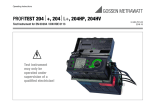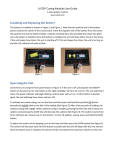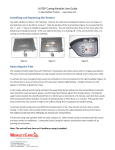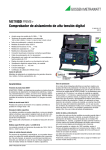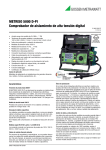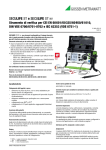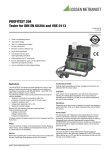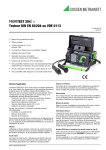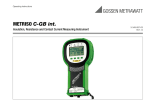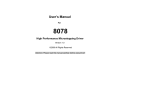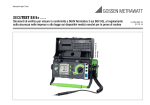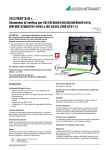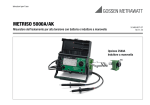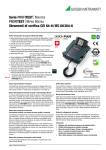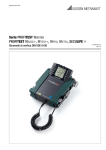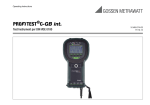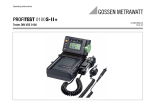Download Gossen Metrawatt METRISO 5000 D-PI - GMC
Transcript
Operating Instructions METRISO 5000 D-PI 3-349-210-03 8/6.13 Digital High-Voltage Insulation Test Instrument Test instrument may only be operated under the supervision of a qualified electrician! 5 4 3 2 1 6 7 8 9 10 14 13 12 12 11 11 15 2 16 17 18 19 GMC-I Messtechnik GmbH 1 Function selector switch Switch positions: SETUP: General device settings Print out measured values and reports Select data memory function OFF: TEST: 2 3 4 5 6 7 8 9 10 11 12 13 14 15 Switches the test instrument off * Select measuring and test parameters, and execute measurements and tests : Select main menus and submenus, and adjust values : Select main menus and submenus, and adjust values Socket connector for RS 232 interface LCD panel Signal lamp for test passed (green) / test failed (red) MENU: Key for selecting and querying menus for setting parameters, for returning to the main menu and for stopping the measuring process i/STORE: Before performing a measurement: Key for querying context sensitive help After performing a measurement: Key for saving measured values and parameters to memory START: Key for starting the selected test Signal lamp: “testing ...” (yellow) Pushbuttons (left and right) for releasing the handle Pushbuttons (left and right) for releasing the cover Cover SECUTEST PSI printer module Handle and bar function as a tilt stand * During battery operation: During mains operation: 16 17 18 19 Inlet plug for supply power with fuse compartment Connector jack for guard cable (feature G1) Connection for automotive charging adapter J1 Device base Outside: With uptake for measurement cable, test probes and alligator clips Inside: Uptake for guard cable with test probe (feature G1), battery compartment ! Attention! Connect 5 m long Leadex 5000 accessory extension cable (feature H1) to + measurement cable only! Note Maximum rated voltage to earth is 1000 V~, even if permanently connected measurement cables for 2 kV~ CAT II are permissible. battery is disconnected transformer is still connected to the mains GMC-I Messtechnik GmbH 3 8 7 4 5 High-Voltage Switching Pistol 1 6 I 2 0 ! 3 PROFITEST 204 HP/HV High-Voltage Module, Connection Panel 4 Retrofitting with a high-voltage module (feature B1 or B2) can only be performed by GMC-I Service GmbH. The high-voltage module is then controlled by METRISO 5000 D-PI. 1 Inlet plug for high-voltage module supply power with fuse insert 2 Key switch for prevention of unauthorized start-up 3 Connection for external signal lamps (see chapter 3.2.3 on page 18) 4 High-voltage module ready for operation when signal lamp is lit up green 5 High-voltage module ready to switch on when signal lamp is lit up red Caution, danger! 6 Permanently connected measurement cables 7 Trigger (switch) As opposed to the high-voltage pistol without switch, the high-voltage switching pistol is identified with a red clamping ring on the connector cable underneath the handle. 8 Recessed safety test probe GMC-I Messtechnik GmbH PC Program WinProfi for communication with METRISO 5000 D-PI The free PC starter software WinProfi is used for communication with your METRISO 5000 D-PI test instrument. WinProfi* is available on our homepage with the following content and functions: • up-to-date test instrument software – for loading a different language for the user interface – for loading an updated software version • Transmission of measurement data from the test instrument to the PC • preparation and modification of templates for test reports at the PC and transmission of the templates to the test instrument • preparation, printout and filing of test reports at the PC The following interface cables and/or converters are required for communication between test instrument and PC: – Z3241 RS232 (tester*) – RS232 (PC) – RS232-USB Converter (Z501L) RS232 (tester*) – USB (PC) * not possible via the RS232 terminal of a connected SECUTEST PSI Up-to-date PC software (free of charge starter or demo software for data management, report and list generation) is available from our homepage for download. * WinProfi is currently applicable up to Windows 7 (32 Bit) GMC-I Messtechnik GmbH 5 Contents Page 1 1.1 Applications ..................................................................................8 List of Available Features ...............................................................9 2 2.1 2.2 2.2.1 2.2.2 2.2.3 2.2.4 2.3 Safety Features and Precautions ................................................10 Checklist for High-Voltage Tests ....................................................11 Significance of Symbols .................................................................12 Symbols on the Device ..............................................................12 Symbols in the Operating Instructions .........................................12 Symbols in the User Interface ....................................................12 Symbols in the User Interface with Feature B1/B2 .......................13 Special Safety Precautions and Instructions for Feature B1/B2 .........................................................................13 3 Initial Start-Up ............................................................................15 3.1 Battery Operation, Feature C1 (not with B1/B2) ...............................15 3.1.1 Removing the Device Base and Inserting or Replacing the Battery Pack .......................................................................15 3.2 Initial Start-Up with Feature B1/B2 .................................................17 3.2.1 Retrofitting Feature B1/B2 .........................................................17 3.2.2 Key Switch (feature B1 or B2) ....................................................17 3.2.3 Indication of Operating States ....................................................18 3.3 Mounting the METRISO 5000 D-PI with Feature B1/B2 to the Trolley (feature D1). .................................................................................19 3.4 Mains Connection .........................................................................20 3.4.1 DC Operation (automotive charging adapter in preparation) ..........20 3.5 User Interface ...............................................................................21 3.6 Help Functions ..............................................................................21 3.7 Setup ...........................................................................................22 3.7.1 Adjusting Contrast and LCD Illumination .....................................22 3.7.2 Setting Date and Time ...............................................................23 3.7.3 Beeper Settings .....................................................................24 3.7.4 Executing the Self-Test ..............................................................25 3.7.5 Downloading a Language or a Software Update .........................26 6 Contents 4 4.1 4.1.1 4.1.2 4.1.3 4.1.4 4.1.5 4.2 4.2.1 4.2.2 4.2.3 4.2.4 4.2.5 4.3 4.3.1 4.3.2 4.4 4.4.1 4.4.2 4.5 4.5.1 4.5.2 4.6 4.6.1 4.6.2 Page Performing Tests ........................................................................29 Insulation (resistance) Test ............................................................29 Setting Test Parameters ............................................................30 Starting the Test (UNOM, UVAR) ...................................................31 Starting the Test (USTEP) ............................................................31 Data logger function (min log)(as of firmware version AH) ............32 Measurements with the Guard Cable (feature G1) ......................33 High-Voltage Test with Feature B1/B2 ............................................34 Performance Test (preparation for testing) ..................................34 Setting Test Parameters for High-Voltage Testing .......................36 High-Voltage Testing Sequence .................................................37 Pulse Control Mode ...................................................................39 Ending the High-voltage Test .....................................................39 Polarization Index Measurement ...................................................40 Setting Test Parameters ............................................................41 Starting the Test .......................................................................41 Breakdown Voltage ......................................................................42 Setting Test Parameters ............................................................43 Starting the Test .......................................................................43 Capacitance Measurement and Determination of Dielectric Discharge (optional) .................................44 Setting Test Parameters ............................................................44 Starting the Test .......................................................................45 Voltage Measurement (protection against residual voltage) ............46 Setting Test Parameters ............................................................47 Starting the Test .......................................................................47 GMC-I Messtechnik GmbH Contents Page 5 5.1 5.1.1 5.1.2 5.1.3 5.2 5.3 5.3.1 5.3.2 5.4 Processing, Reorganizing and Deleting Data ............................. 48 Select Device under Test (DUT) .................................................... 48 Entering Descriptions ............................................................... 49 Copying Descriptions ............................................................... 50 Deleting Descriptions ............................................................... 50 Processing Data (checking measured values) ................................ 50 Data Reorganization ...................................................................... 51 Deleting Already Printed Data ................................................... 51 Memory Test ........................................................................... 51 Clearing the Memory ................................................................... 52 6 Printing Test Results ................................................................. 53 7 Characteristic Values ................................................................. 54 Contents 11 11.1 11.2 11.3 11.4 Page Appendix .................................................................................... 64 Glossary ..................................................................................... 64 Minimum Display Values in Consideration of Measuring Error ........................................................................... 64 Voltage at Device Under Test During Insulation Resistance Test ...................65 Index ........................................................................................... 66 12 Repair and Replacement Parts Service, Calibration Center and Rental Instrument Service .................................67 13 Product Support ......................................................................... 68 8 Data Interfaces ........................................................................... 57 8.1 RS 232 Serial Interface ................................................................. 57 8.1.1 Software Analysis of Measurement Results ................................ 57 8.1.2 Interface Specification and Protocol ........................................... 57 8.1.3 Connector Pin Assignments ....................................................... 57 9 Displays and Error Messages – Causes – Remedies ................ 58 10 10.1 10.2 10.3 10.4 10.5 10.6 10.7 10.8 10.9 Maintenance .............................................................................. 61 Replacing the Mains Fuse ............................................................. 61 Testing of Rechargeable Batteries ................................................. 61 Housing and Test Probes .............................................................. 61 Measurement Cables .................................................................... 62 High-Voltage Module Test Cables (Feature B1/B2) .......................... 62 Replacing Bulbs in the External Signal Lamps (Feature F1) .............. 62 Software ...................................................................................... 62 Recalibration ................................................................................ 63 Device Return and Environmentally Compatible Disposal ................. 63 GMC-I Messtechnik GmbH 7 1 Applications The METRISO 5000 D-PI insulation measuring instrument is in compliance with the following standards and regulations: Standard DIN EN 61557-1:2007 DIN EN 61557-2:2008 VDE regulation VDE 0413 Part 1:2007 VDE 0413 Part 2:2008 “Equipment for testing, measuring or monitoring protective measures in systems with line voltages of up to 1000 V AC and 1500 V DC, part 2, insulation resistance measuring instruments”. The instrument is suitable for the measurement of insulation resistance at voltage-free devices and equipment with nominal voltages of up to 1000 V. It is also suitable for the measurement of insulation resistance with values of up to 1 T, and open-circuit voltages of up to 5000 V. The instrument is also equipped with a 1000 V measuring range for direct and alternating voltages. This provides users with the advantage of checking devices under test for the absence of voltage, and discharging capacitive devices under test. All of the values required for approval reports can be measured with this instrument. The SECUTEST PSI module (feature I1) – a printer which can be inserted into the cover which includes an integrated interface and keypad – expands the range of possible applications for the METRISO 5000 D-PI. All measured data can be archived with the help of measurement and test reports which can be printed out directly via a PC. This is a very important feature, especially with regard to product reliability. 8 Notes Regarding SECUTEST PSI Operating Instructions In combination with the METRISO 5000 D-PI, the SECUTEST PSI printer module is only used for printing out measured values and for entering comments with the alphanumeric keypad. The following chapters from the SECUTEST PSI operating instructions are relevant as regards operation together with the METRISO 5000 D-PI: • Chapter 2 Safety Features and Precautions • Chap. 3.1 and 3.2Installing the Batteries and the PSI Module • Chapter 12 Characteristic Values • Chapter 13 Maintenance • Chapter 14 Repair and Replacement Parts Service The following functions are not active, or only make sense in combination with a SECUTEST test instrument: • Display, print and store reports to memory • Statistics • Operation with a barcode scanner GMC-I Messtechnik GmbH 1.1 List of Available Features Features Country version (user interface language, mains plug type) 0 01 D A PROFITEST204HP/2.5kV 1) B none (not with C1) 03 04 05 07 08 09 10 11 12 13 14 15 17 22 40 41 42 43 GB inter- GBR nati- UK onal 02 FRA F NLD NL ESP E FIN FIN SWE S ITA I NOR N BEL B DNK DK CZE CZ CHE CH KRO HR POL PL Port P Slo SLO Slow SK USA USA with PROFITEST204HV/5.4kV 1) B none (not with C1) with2) Set of batteries (not with B1, B2) C none with “Guard 5000A” measurement cable G none with “LEADEX 5000” extension cable H none with SECUTEST PSI printer module I none with 1) If the high-voltage module is purchased after the basic instrument, it can only be retrofitted by our service department. 2) Only for line voltage 207 V 253 V / 49 Hz 61 Hz Specify the designation of the basic M5810 instrument in your order, as well as any features which deviate from feature 0! Example of a complete type designation (= article number, = order code) for a METRISO 5000 D-PI: – GMC-I Messtechnik GmbH Test instrument for German speaking countries with DAkkS calibration certificate and SECUTEST PSI printer module: M5810 A01 I1 9 2 Safety Features and Precautions The METRISO 5000 D-PI test instrument, and the PROFITEST204HP/2.5kV and PROFITEST204HV/5.4kV high voltage modules have been manufactured and tested in accordance with the following safety regulations: Standard DIN EN 61557-1:2007 DIN EN 61557-2:1998-05 IEC 61010-1:2004 EN 61010-1:2002 VDE regulation VDE 0413 Part 1:2007 VDE 0413 Part 2:1998-05 VDE 0411 Part 1:2002 If used for its intended purpose, safety of the user, the instrument and the device under test is assured. Read the operating instructions completely and carefully before using the device, and follow all instructions included therein. The operating instructions should be made available to all users. Observe the following safety precautions: • The instrument may only be connected to a 230 V or 120 V electrical system (depending on the country-specific design) which is protected with a fuse or circuit breaker with a maximum nominal current rating of 16 A. • Be prepared for the occurrence of unexpected voltages at devices under test (for example, capacitors may be dangerously charged). • Make sure that connector, measurement and test cables are not damaged (i.e. broken insulation, kinks, interruptions etc.). • The instrument may only be used indoors. • Impulse withstand voltage of up to 2.5 kV may occur in measurement category II systems with 230/400 V. 10 • If only the batteries are to be charged (instrument is ready for operation in SETUP position), please ensure that the test instrument cannot be used by unauthorized personnel during the charging process. • Measurement may only be performed on voltage-free equipment and devices. • Measurements may not be performed under moist ambient conditions, where condensation has occurred, or in explosive atmospheres. • Do not disconnect the measurement cables until the device under test has been fully discharged. • Observe accident prevention regulation BGV A3, “Electrical Systems and Equipment”. • Do not perform measurements alone: always have a second person help if possible. • Make sure that measurement cables are connected correctly. • Do not touch the test probes at any point beyond the finger guard. The METRISO 5000 D-PI may not be used: • If visible damage is apparent • With damaged connector, measuring or test cables (test cables may not, under any circumstances, be mechanically damaged or kinked, because impaired insulation characteristics may otherwise result) • If these no longer function flawlessly • If the signal lamps on the PROFITEST204HP/2.5kV (feature B1) and PROFITEST204HV/5.4kV (feature B2) highvoltage modules are defective In such cases, the devices must be removed from service and secured against any possible inadvertent use. Send the instrument to our Repair and Replacement Parts service department in such cases (see chapter 12 on page 67). GMC-I Messtechnik GmbH Opening of Equipment / Repair The equipment may be opened only by authorized service personnel to ensure the safe and correct operation of the equipment and to keep the warranty valid. Even original spare parts may be installed only by authorized service personnel. In case the equipment was opened by unauthorized personnel, no warranty regarding personal safety, measurement accuracy, conformity with applicable safety measures or any consequential damage is granted by the manufacturer. 2.1 ! Safety Precautions for the Machine Under Test (recommended) Ð Ð Ð Ð Ð Ð Checklist for High-Voltage Tests Ð Ð Attention! Measurements may not be performed under moist ambient conditions, where condensation has occurred or in explosive atmospheres. Personnel Safety Ð Turn the machine under test off and lock it in the off position. Ð Perform insulation resistance measurement. Ð Make sure that the system is grounded. Ð Secure the danger zone with barriers, closing even narrow entrance ways. Ð Set up warning signs such that they are plainly visible. Review the circuit diagrams and make a note of all electrical circuits. Disconnect the neutral conductor from the mains. Short circuit each electrical circuit to itself. Disconnect control circuits with overvoltage arresters, if the arresters would be triggered by utilized test voltage. Disconnect PELV circuits (no high-voltage testing is required for these circuits). Test insulation at each circuit with 1000 V. (If insulation resistance is OK at 1000 V, no failures should occur during the high-voltage test.) Disconnect frequency converters. Caution in TN systems! The protective conductor is connected to the neutral conductor in the junction box. High-voltage is thus applied between the phase conductors and the neutral conductor. The neutral conductor must be cut if necessary, because it is not disconnected from the mains by means of fuses. Setting Up the Test Instrument High-Voltage Test Ð Test all circuits (conductors) against the protective conductor (all switches in the mains circuit must be turned on, and testing must be performed upstream and downstream from all relays and contactors). Ð Remove all shorting devices after testing has been completed. Ð Set up warning lamps such that they are plainly visible. Testing Without Short-Circuiting Ð Attach the emergency stop button in a plainly visible fashion. Ð Warn personnel working in the area of possible danger. Ð Separately test all conductors from all circuits against the protective conductor (the machine could be damaged in the case of arc-over). Ð Always turn the test instrument off with the key switch and remove the key before leaving the work area. Functions Test Ð The machine must be tested for correct functioning after the high-voltage test, especially as regards safety functions. GMC-I Messtechnik GmbH 11 2.2 Significance of Symbols 2.2.3 Symbols in the User Interface 2.2.1 Symbols on the Device The symbols on the device have the following meanings: High-voltage warning, Voltage at the test probe between 1000 and 5000 V Indicates EC conformity ! Life endangering for the operator if the wiring diagram and the operating instructions are not observed! Warning concerning a source of danger (attention: observe documentation!) This device may not be disposed of with the trash. Further information regarding the WEEE mark can be accessed on the Internet at www.gossenmetrawatt.com by entering the search term ’WEEE’. Report functions Warning concerning a source of danger, Voltage at the test probe between 25 and 1000 V Insulation measurement: interference voltage at the test probes All-clear after an insulation test: voltage at test probes less than 25 V Timer function: symbolizes test duration Data management 2.2.2 Symbols in the Operating Instructions Life endangering for the operator if instructions identified with this symbol are not observed ! 12 Danger for the operator and the device if instructions identified with this symbol are not observed This symbol appears after the voltage measurement value has been frozen (see chapter 4.6 on page 46). Indicates progress of the test. Indicates storage of the measurement value. GMC-I Messtechnik GmbH 2.2.4 Symbols in the User Interface with Feature B1/B2 or or High-voltage module ready to be switched on Life endangering high voltage of up to 5.35 kV is present at the test probes of the highvoltage module. Test completed successfully, residual voltage less than 25 V Display of phase angle The specified limit value IMAX has been exceeded. Current limiting has switched the device to the “standby” mode. The last voltage value measured before interrupting current was exceeded, as well as interrupting current limit value IMAX are displayed Excessive temperature inside the test instrument (high-voltage test) Allow the device to cool for approximately 10 minutes. 2.3 Precautions for the prevention of inadvertent start-up: • Multiple key operation: Before test voltage can be applied to the test probes by activating the trigger at the high-voltage switching pistol, the START key must be pressed at the primary device. • Two-hand operation: Each of the high-voltage pistols is equipped with a trigger. Both triggers must be activated simultaneously in order to expose both test probes. • High-voltage switching pistol (pistol with yellow marking) with double safety feature: If the trigger at the high-voltage switching pistol is pulled to the first point of mechanical resistance, the test probe is exposed. High-voltage is not applied to the test probe until the trigger is pulled beyond this point, assuming the device is switched on. General Safety Precautions • Integrated signal lamps indicate the switching status of the test instrument. • Test probes are electrically isolated from the mains: This prevents current from flowing from the high-voltage switching pistol to earth. • Current limiting in the event of arc-over: If the current limit value entered as a device parameter is exceeded due to arc-over, switching to the “standby” mode takes place automatically. • When mains voltage is restored after a power failure, switching to the “standby” mode takes place automatically. Special Safety Precautions and Instructions for Feature B1/B2 Precautions for the prevention of unauthorized start-up: • Key switch GMC-I Messtechnik GmbH 13 ! ! ! Attention! The vent slots in the bottom of the high-voltage module may not be covered! Attention! Observe the Rules for Electrical Testing Equipment issued by the GERMAN TRADE ASSOCIATION FOR PRECISION ENGINEERING AND ELECTRICAL ENGINEERING (see enclosed brochure). Attention! Observe DIN VDE 0104 regulations: “Setup and Operation of Electrical Test Equipment” Attention High-Voltage! When the trigger at the high-voltage switching pistol is pulled to the first point of discernible mechanical resistance, the test probe is exposed. If the trigger is pulled beyond this point of mechanical resistance, high-voltage is applied to the test probe, assuming the high-voltage module is in the “standby” mode. Attention High-Voltage! Touch neither the test probe nor the device under test during the high-voltage test! Life endangering high-voltage of up to 5.35 kV is present at the test probes of the high-voltage module! Limitation of Liability ! ! 14 Attention! If safety test probes are used, the operator must inspect them to assure that the test probes and their cables are in flawless condition before placing them into service. All equipment must be inspected for visible, external damage before use (see chapter 10.3 on page 61 through chapter 10.5 on page 62). Attention! Before initializing any tests, and before enabling test equipment, make sure that all means of access to the danger zone are closed, and that all persons have exited the danger zone. PCs located in proximity to the test equipment may “crash” in the event of arc-over, resulting in possible data loss. All data and programs should be suitably saved, and computers shut down before performing the high-voltage test. PCs may crash even if no RS 232 connection has been established. The manufacturer of the test instrument assumes no liability for direct or consequential damages to computers or peripheral devices, or for data loss during performance of the high-voltage test. Furthermore, the manufacturer assumes no liability for defects at devices under test resulting from the high-voltage test. This applies in particular to electronic components included in the device under test. Observe checklist for performance of high-voltage tests in chapter 2.1. GMC-I Messtechnik GmbH 3 Initial Start-Up The METRISO 5000 D-PI test instrument is supplied with a base which serves as a compartment for storing test cables, the guard cable (feature G1), the test probes and the battery pack (feature C1). ! 3.1 Attention! The test instrument may only be operated if the base is properly attached and secured. Battery Operation, Feature C1 (not with B1/B2) The battery pack is required for operation of the METRISO 5000 D-PI without mains power. The battery back includes 8 NiMH batteries. No other battery packs may be used. The battery pack is charged automatically by the integrated mains power pack. Optional use of an automotive charging adapter is also possible. The device must be switched on in this case (any switch position other than OFF). ! Attention! If only the batteries are to be charged (instrument is ready for operation in SETUP position), please ensure that the test instrument cannot be used by unauthorized personnel during the charging process. GMC-I Messtechnik GmbH 3.1.1 Removing the Device Base and Inserting or Replacing the Battery Pack Please observe instructions included in this chapter if the device is to be retrofitted with a battery pack, or if the battery pack requires replacement. ! Attention! Before dismantling the device base: – Disconnect the device from the measuring circuit at all poles. – Disconnect the device from mains power. – Turn the device off (set the switch to OFF). Ð Close the cover and position the handle at the side of the device. Ð Turn the device upside down, i.e. place it onto its cover. Ð Unwind the test cables from the cable uptake at the side. Ð Remove the guard cable from the device base if one is included (feature G1). Ð Loosen the three Phillips head screws at the bottom of the device base. Ð Lift the device base up, and set it down at the side of the device with the feet at the bottom. Ð Place the battery pack onto the two rubber cushions in the recess in the device base such that the connector cable with plug connector from the battery pack is on the same side as the device’s connector cable with socket connector. Double-check: The opening at the side of the base coincides with the device’s connection panel. 15 Ð Connect the two cables to each other and secure the connection with the snap hooks. Ð Position the cable such that is cannot be pinched during subsequent assembly. Ð Carefully set the device onto the base as shown in the photo by grasping the handle with one hand, and guiding the bottom of the device into position with the other hand. Ð Grasp the base and the device, and turn the entire unit upside down. Ð Secure the base with the included screws and washers. 16 GMC-I Messtechnik GmbH ! Attention! Use only the screws furnished with the device together with washers. Longer screws may reduce creepage distances or damage the device. Possible Danger of Pinching! If a battery pack (feature C1) has been installed and the device is not connected to the mains, the battery symbol appears at the display when the device is switched on, and the number of dark bars displayed in the symbol indicates the battery charge level. After installing the battery pack, the device is automatically supplied with power from the batteries. 3.2 Initial Start-Up with Feature B1/B2 3.2.1 Retrofitting Feature B1/B2 Retrofitting with a high-voltage module (feature B1 or B2) can only be performed by GMC-I Service GmbH. The METRISO 5000 D-PI serves to determine the insulation value in a non-destructive manner. If it is too low, it is possible to detect the weak point with the high-voltage module (B1 or B2). 3.2.2 Key Switch (feature B1 or B2) The key switch prevents unauthorized start-up of the high-voltage module. Keep the key in a safe place which can only be accessed by authorized personnel. Torn the key to the “0” position and remove after each test has been completed. Note When the key is removed or the high-voltage module is turned off, the menu functions for the high-voltage module cannot be accessed at the METRISO 5000 D-PI! GMC-I Messtechnik GmbH 17 3.2.3 Indication of Operating States Signal Lamps at the High-Voltage Module The signal lamps integrated into the high-voltage module indicate two different operating states: Green: Test instrument ready for use • Key switch is in the “I” position (ON). • Power supplies for signal and control circuits at the high-voltage module are switched on. • Test voltage supply circuits are still switched off, and are still secured against inadvertent activation. ! Attention! All safety precautions required before entering the danger zone must now have been implemented, amongst others: set up WS1 warning signs and ZS2 auxiliary signs in accordance with DIN 40008, part 3. ! Attention! All means of access to the danger zone must be closed when the high-voltage module is in the “standby” mode! The device must be sent to GMC-I Service GmbH in order to replace lamps. External Signal Lamps (feature F1) The external signal lamps indicate the same operating states as the signal lamps integrated into the high-voltage module. They provide additional security at the test site, and must be plainly visible beyond the boundaries of the danger zone. The external signal lamps can only be connected to the 12 V/5 W output jack at the high-voltage module (feature B1 or B2). Note For reasons of safety, only Z504D signal lamps available from GMC-I Messtechnik GmbH may be used. Refer to chapter 10.7 on page 62 regarding lamp replacement Red: Instrument ready for operation, caution: danger! • The menu for starting the voltage test has been opened, and the START key has been activated. • The power supply circuit for the safety test probe is still switched off, assuming the trigger has not been pulled at the high-voltage pistol. • The test probes are secured against inadvertent contact, assuming the triggers at the high-voltage pistols have not been pulled. 18 GMC-I Messtechnik GmbH 3.3 Mounting the METRISO 5000 D-PI with Feature B1/B2 to the Trolley (feature D1). Ð Set the complete unit consisting of test instrument and high-voltage module onto the trolley’s platform (1) such that the cover of the test instrument can still be opened. 11 Ð Secure the test instrument’s handle to the vertical supports with the handle clamps (3). Loosen the screws in the handle clamps (9) to this end with a 4 mm hollow hex wrench. 2 Ð Push the handle clamps (3) over the handle and retighten the screws (9). 9 Ð Wind the two cables from the safety test probes onto the bottom cable uptake (2 at bottom). 3 Ð Then wind the two cables from the test instrument’s test probes onto the top cable uptake (2 at top). 8 Ð Secure the cables and the test probes with the included rubber straps (12). 2 ! Attention! Observe regulations for portable test equipment in accordance with DIN VDE 0104 (3.6). Item Designation Qty. Order Number 1 2 3 4 5 6 7 8 9 10 11 12 13 Base Cable uptake Handle clamp Cover Wheel Washer Retaining ring Screw Hex nut Screw Trolley frame Rubber strap Protective cover 1 2 2 2 2 4 2 6 6 2 1 2 1 3-117-193-01 3-326-653-01 3-326-652-01 3-164-609-01 3-419-038-01 3-740-013-01 3-743-024-59 3-712-007-10 3-730-119-12 3-716-018-24 3-121-111-01 3-326-627-01 3-171-302-01 4 1 10 Note Wind the test cables from the safety test probes onto the provided cable uptakes at the back of the trolley after each use. Test cables may not, under any circumstances, be mechanically stressed or kinked, because impaired insulation characteristics may otherwise result. Do not forget that externally caused damage is not always recognizable. GMC-I Messtechnik GmbH 6/7 5 ! Caddy 204 Trolley Attention! Inspect the test cables for mechanical damage before placing the high-voltage module into service each time it is used. 19 3.4 Mains Connection ! U L – N = 230 V L1 N green-yellow PE L1 L2 L3 N green-yellow Attention! If a connection via earthing contact outlet is not possible, disconnect the mains from all sources of voltage before connecting the cables of the coupling socket via pick-up clips with the mains connections, as shown in the drawing. PE L1 L2 L3 If a battery pack has not been installed, the mains connection symbol appears after the test instrument has been switched on. If a battery pack has been installed (feature C1), it is automatically recharged. The battery symbol appears at the display, and the blinking bars shown in this symbol indicate the remaining capacity which still needs to be charged. The device need not be disconnected from mains power after the batteries have been fully charged (overcharge protection). N green-yellow 3.4.1 DC Operation (automotive charging adapter in preparation) If a battery pack (feature C1) has been installed and the device is not connected to the mains, the battery symbol appears at the display when the device is switched on, and the number of dark bars displayed in the symbol indicates the battery charge level. After installing the battery pack, the device is automatically supplied with power from the batteries. The automotive charging adapter (feature J1) can be used to operate the device and charge the batteries. Ð Connect the test instrument to 230 V or 120 V mains power (depending on the country-specific design) with the included mains connector cable. 20 GMC-I Messtechnik GmbH 3.5 User Interface Measuring and testing with the METRISO 5000 D-PI is quick and easy. The integrated user interface provides the operator with information regarding required operating steps, operator errors, measurement results and more for all measuring functions. All information and measurement results appear at a dot matrix LCD panel in plain text. The integrated user interface is entirely adequate for the great majority of all tests and measurements. Nevertheless, operators should carefully read and understand the contents of these operating instructions. 3.6 Ð Press the STORE key in order to query online help: STORE Query Help Ð Press the same key once again, or the MENU key, in order to exit the help function: Help Functions MENU Help texts can be queried and displayed at the LCD for all measuring and test functions, and for practically all settings. Exit Help Example: Display Contrast Function or SETUP Switch Position Ð Start the selected function directly from the help menu by pressing the START key: START Start Function GMC-I Messtechnik GmbH 21 3.7 Setup Various basic settings can be selected for the test instrument with the selector switch in the SETUP position. 3.7.1 Adjusting Contrast and LCD Illumination Contrast can be increased or decreased with this function. LCD illumination can be switched on or off as well. SETUP SETUP Select Parameter Select Display Contrast MENU MENU Open Menu for Entering Parameters Open Entry Menu All setting and changes entered to the menu accessed in the SETUP switch position are saved to memory automatically, and are retained after disconnecting the device from mains power. Adjust Contrast MENU Exit Function START Restoring default setting – standard values Switch off the test instrument: switch position OFF. Then press and hold the MENU and i/STORE keys simultaneously, and turn the function key to TEST position. The standard values of the default setting are thus restored. 22 Switch Illumination On or Off * * Background illumination is switched off automatically after approximately 2.5 minutes if none of the keys are activated during this time. Each time a key is activated, background illumination is extended for an additional 2.5 minutes. GMC-I Messtechnik GmbH 3.7.2 Setting Date and Time The test instrument’s internal clock can be set with this function. The clock continues to run after supply power has been disconnected. Date and time are included in the test reports. Entries are made using the following formats: Date: DD.MM.YYYY (Day.Month.Year) Time: hh:mm (Hour:Minute) SETUP Select Date/Time MENU Open Entry Menu (and select date or time) START Select Cursor Position Change Values GMC-I Messtechnik GmbH 23 3.7.3 Beeper Settings The beeper can be completely deactivated or activated as indicated in the table below. Beeper deactivated Beeper activated Beeper for measuring functions Beeper for high-voltage Beeper upon key stroke — — — Beeper upon good/ bad measurement results * — — Intermittent beeper for highvoltage > 1000 V — — Intermittent beeper for operation with Feature B1/B2 SETUP Select Beeper MENU Open Entry Menu * a good measurement result (passed) is indicated with one long acoustic signal, a bad result (failed) with three brief acoustic signals. Select Beeper Function 24 GMC-I Messtechnik GmbH 3.7.4 Executing the Self-Test This function displays important device data first. If required, display lamp and relay functions, as well as other options, can be tested automatically and results appear at the display. START SETUP Battery Voltage and LED Test START Select Self-Test Continue Test MENU Open Entry Menu 3 Results: OK Error message: – Test failed – component defective – component not available (e.g. batteries not inserted or high-voltage module not available) LCD Test Neighboring horizontal and vertical segments of the LCD panel are activated separately or test images are indicated by means of the following tests. If one of the segments fails to blink, send the test instrument to an authorized service center for repair. GMC-I Messtechnik GmbH Note Before a check mark appears to indicate correct functioning the LEDs must first blink, and the relays must switch. 25 3.7.5 Downloading a Language or a Software Update A Installing WinProfi to the PC and Starting the Program If you require a language other than one of those included with the instrument, it can be downloaded with the help of WinProfi* PC software. The data file with the desired language is transmitted to the test instrument via the serial interface. The previously installed language is overwritten. Software updates can be downloaded with the help of the same program, regardless of the currently installed language. Ð Download the WinProfi software from our homepage: http://www.gossenmetrawatt.com ( Products Software Software for Testers WinProfi) Note You can use WinProfi software at the PC side (included with the METRISO 5000 D-PI) to download a language to the test instrument. This software includes all of the functions required for communications between the METRISO 5000 D-PI and the PC. A description of the program is included in the online user’s manual which can be accessed from WinProfi. Ð Unzip the zip file „winprofi.zip“. Ð Install the software on your PC by executing file Setup_WinProfi_Vx.xx.exe. Ð Select the desired language for the WinProfi software and for the user interface of the test instrument. Ð Follow the instructions which appear at the monitor. The program is added to your start menu after installation. Displaying and printing out the online user’s manual (contains information concerning the software which is not included in these operating instructions). * WinProfi is currently applicable up to Windows 7 (32 Bit) 26 GMC-I Messtechnik GmbH B Prerequisites for Software Update or Exchange of Data C Transmitting a Software Update to the Test Instrument Ð Find the interface to which the METRISO 5000 D-PI is connected. Ð PC: Select Update all from the update menu. Follow the instructions which appear at the monitor. Note Always start this function first, before performing an update or changing report templates. After starting this function, WinProfi loads the report files required specifically for the connected instrument. Due to the fact that WinProfi has been created for use with several types of test instruments, incorrect test reports may otherwise be loaded, or erroneous options may be made available. Ð Querying information regarding current software version Depending upon the utilized PC, updating takes from 1 to 2 minutes. The green LED indicates that the instrument is ready to receive data. If the PC and the test instrument are correctly synchronized, the yellow LED lights up and the green LED goes out. The red LED lights up during programming sequences. After transmission has been completed, the LED goes out and the device is restarted. The message “Transmission done” appears at the PC. ! Attention! The instrument may not, under any circumstances, be switched off during transmission, nor may the connection between the instrument and the PC be interrupted! • Subsequently select “Language” (loading the respective language), if applicable. GMC-I Messtechnik GmbH 27 D Organizing Report Data • Editing and transmitting report templates Ð Connect the test instrument directly via cable Z3241 with the PC. Note Do not connect the PC to the PSI module. • Sending and receiving data • Printing out data 1 2 3 6 5 4 • 28 GMC-I Messtechnik GmbH 4 Performing Tests Each of the following tests is automatically assigned to one currently available object number. Any given test which is saved to memory with the “STORE” key is stored with reference to this number. The object number can be entered in the “DUT data” menu (see chapter 5.1 on page 48). Measuring mode operation is always carried out according to the following sequence: • Select the desired test. • Enter test parameters (if required). • Start the measurement or return to the initial menu. • Save measured values to memory and enter a description (if desired). Observe the following for all tests: • Safety features and precautions, see chapter 2. • Disconnect the device under test from all sources of voltage first. • Test for absence of voltage. • Do not disconnect the measurement cables until the device under test has been fully discharged. GMC-I Messtechnik GmbH 4.1 Insulation (resistance) Test Test voltage can be set between 100 V and 5,000 V for this test. This voltage, as well as the allowable limit value for insulation resistance, can be selected as a test parameter. Voltage at the device under test appears at the LCD in addition to measured insulation resistance. Discharge After the measurement has been completed, the device under test is discharged automatically in order to assure zero voltage. The falling voltage value can be observed at the display during the discharging process. The measured insulation resistance value remains in memory during this period of time. Interference Voltage If voltage is present at the test probes after measurement is started, an “external voltage” warning appears at the display. The level of the interference voltage is shown at the display. The insulation test is aborted after the test probes have been removed from the DUT. The test has to be conducted again on the de-energized DUT. 29 4.1.1 Setting Test Parameters ! Attention! Do not touch the test probes during measurement! A direct voltage of up to 5000 V is present between the test probes. Note Testing the Measurement Cables: Initial testing should be performed after short-circuiting the measurement cables with their test probes. The instrument should display nearly zero M. A broken measurement cable can be detected in this way. The type of utilized test voltage can be selected here: • Fixed test voltage • Variable test voltage (e.g. lower test voltage for voltage-sensitive components) • Test voltage in a sequence of steps (USTEP = step voltage), e.g. in order to allow for better evaluation of insulation quality with regard to dielectric strength Additional parameters must be set as well depending upon the selected type of test voltage. MENU Select Parameter TEST Select the Test Set Value MENU Open the Submenu 30 GMC-I Messtechnik GmbH Significance of Parameters with Variable and Fixed Test Voltage Test voltage Unom: Test voltage in fixed steps (100/250/500 V, 1.00/1.50/2.00/2.50/5.00 kV) Uvar: Variable test voltage (100 V 5.00 kV in 50 V steps) Test voltage Uins Limit Rins Limit value for insulation resistance (If value stays below limit value: measurement failed) Test duration Maximum test duration in seconds <Auto>: measurement until steady state is reached Time in sec.: Measurement = 1 to 120 seconds >>>>: cont. measurement: stop with MENU key Time in min log:Measurement = 2 to 60 minutes with automatic storage of 30 measured values at equal time intervals including information on the current test time. (see chapter 4.1.4 on page 32). Significance of Parameters with Step Voltage Test voltage as a sequence of steps Test v. Ustep: U(INS) END Final value of the step sequence (250 V 5.00 kV in steps of 250 V) RLim Maximum allowable statistical deviation from the measured mean value t/250V Dwell time per step (10 s 50 s) 4.1.2 Starting the Test (UNOM, UVAR) START Display of results after completion of test 4.1.3 Starting the Test (USTEP) START Resetting parameter values to default setting, see page 22. Note In the event of very high insulation resistances the capacitive influence of the person performing the measurement and/or of the measuring cable may distort the measured value. GMC-I Messtechnik GmbH 31 4.1.4 Data logger function (min log)(as of firmware version AH) MENU Statistical analysis Select Parameter Press the CURSOR DOWN or CURSOR UP keys to return to the previous LCD display. If you choose time parameter setting "min log" from the menu, exactly 30 measured values are automatically stored during the selected test duration at time intervals between 4 seconds and 2 minutes. This makes data logger operation possible for measuring durations between 2 and 60 minutes. In this case, the residual time of the current measurement is not indicated in seconds, but in minutes. While the test is being performed, icon “Stored” is briefly shown in the display and the yellow signal lamp “Testing ...” disappears briefly each time a measured value is being stored. If the signal generator is activated, an acoustic signal sounds additionally. In this function, the current test time is stored for each measurement instead of the parameter for the test duration to ensure the temporal correlation between measured value and time of measurement. Note If the measuring range is exceeded (overflow of display range), no statistical analysis will be performed. In this case, the individual measured values are listed, but no value for RMAX is calculated. STORE Press briefly: Save results Press & hold: Save results and activate the entry field: A description of the measurement with up to 15 characters can be entered to the information field at the bottom. See chapter 5.1.1 regarding entry. 32 Note Before the start of each test with data logger as described in chapter 5.1, select a new device under test to avoid the measured values being stored successively within the same DUT. This considerably facilitates the subsequent evaluation of the stored measured values. GMC-I Messtechnik GmbH 4.1.5 Measurements with the Guard Cable (feature G1) The measurement of very high resistances necessitates extremely minimal measuring current and may be rendered problematic as a result of influences such as electromagnetic fields, humidity or surface current. An accurate test set-up is thus absolutely essential. A guard cable must be used for measurements within a range of 100 G (10 G) 1 T, in order to prevent surface current from distorting measurement results. The guard rings prevent current at the surface of the insulation material from flowing from the +measurement cable to the –measurement cable, instead of through the insulation material itself. Note The following materials can be used as guard rings: aluminum foil, copper foil or metallic hose clamps. Guard Cable –Measurement Cable +Measurement Cable Contact Ring Conductor Insulation Material Guard Rings Ð Insert the plug from the guard cable into the appropriate jack in the test instrument. Ð Plug the alligator clip onto the guard cable test probe. Ð Connect the alligator clip to the guard ring between the two measuring points at the insulation material under test. Ð Refer to chapter 4.1.2 on page 31 regarding the measuring sequence GMC-I Messtechnik GmbH 33 4.2 High-Voltage Test with Feature B1/B2 The electrical equipment of the machine under test must withstand a test voltage of twice its own rated voltage value or 1000 V~ (whichever is greater) applied between the conductors of all circuits and the protective conductor system for a period of at least 1 second. The test voltage must have a frequency of 50 Hz, and must be generated by a transformer with a minimum power rating of 500 VA. b) Voltage Test Ð Set the key switch to the “I” position. • The green signal lamps must light up. Ð Select the insulation test with the or the key. TEST Note Feature B must be included for testing in accordance with DIN VDE 0113. Feature B2 is used for testing at up to 5 kV. The METRISO 5000 D-PI automatically recognizes which type of high-voltage module has been connected. Communications between the test instrument and the high-voltage module can be tested as described in chapter 3.7.4. ! Attention! Before beginning work, the test instrument, the high voltage cables and the high-voltage pistols must be inspected to assure that they are in flawless condition (see also chapter 10.5 on page 62). 4.2.1 Performance Test (preparation for testing) Execute the following performance test in the specified order from a) through e). a) Key Switch Ð Set the key switch to the “0” position. • Neither the green nor the red signal lamps may light up. Select the Test MENU Open the Submenu The test voltage parameter is switched from UNOM or USTEP to AC-HV. Ð Set parameters for test duration, test voltage, interrupting current IMAX and rise time to the desired values (see chapter 4.2.2 on page 36). Note Do not set IMAX to pulse control mode! Ð Press the START key. • The red signal lamps must light up. • The following values appear at the LCD: UT = – – – V IT = – – – mA The following symbols appear: 34 GMC-I Messtechnik GmbH d) Power Failure Attention High-Voltage! Touch neither the test probes nor the device under test during the high-voltage test! Life endangering high-voltage of up to 5.3 kV is present at the test probes of the high-voltage module! Ð Pull the trigger of the identified high-voltage switching pistol to the limit stop and hold. • The following values and symbols appear at the LCD: UT = acquired voltage value IT 00.0 mA or 0.00 mA • After the specified test time has elapsed, test voltage is switched off automatically and the following appears: • If the trigger (switch) is release prematurely, the test is aborted. c) Shutdown Functions Ð Short circuit the two high-voltage pistols. Ð Pull the trigger of the identified high-voltage switching pistol to the limit stop and hold. • The instrument is shut down immediately. • The green signal lamps must light up, and the red signal lamps may not light up. • The following values appear at the LCD: UT = XXX V IT = > XXX mA The last voltage value measured before interrupting current was exceeded and breaking current limit value IMAX are displayed. The following symbols appear: GMC-I Messtechnik GmbH Ð Press the START key. • The red signal lamps must light up. Ð Set the key switch to the “0” position and wait at least 1 second. Ð Set the key switch to the “I” position. • The green signal lamps must light up, and the red signal lamps may not light up. e) Indicator Signals Signal Lamps Two lamps are included on the test instrument, arranged diagonally, for the indication of operating states. If both “ready for operation” lamps (red) go out, test voltage is no longer generated. Do not start voltage testing unless all signal lamps indicate correct operation. Replace defective lamps as described in chapter 10.6 under “Maintenance”. Acoustic Signals (acoustic signal “on” or “measuring mode operation”) Ready Repetitive sequence 0 1 2 3 t [s] 0 1 2 3 t [s] 0 1 2 3 t [s] Test in Progress Repetitive sequence IT > IMAX Single sequence Refer to chapter 3.7.3 on page 24 regarding activation. 35 4.2.2 Setting Test Parameters for High-Voltage Testing The following parameters can be set in the “standby” mode with illuminated green signal lamps: MENU Test v. UAC.MAX. AC-HV Max. test voltage, final value after TR has elapsed Setting limits: HP-2.5kV: 250 V 2.50 kV HV-5.4kV: 650 V 5.35 kV IMAX.: Max. allowable current before high-voltage is switched off Setting limits: HP-2.5kV: 10.0 250 mA HV-5.4kV: 0.50 10.0 mA The pulse mode symbol >>>>>>> can be selected with the key at less than 10.0 or 0.50 mA. TD: Test duration at maximum test voltage UAC.MAX. (not including rise time TR) Setting limits: 1.00 120 s, the continuous operation symbol >>>>>>> can be selected at under 1.00 s with the key. TR: Rise time: time, during which test voltage rises to the selected value UAC.MAX. Setting limits: 100 ms 99.9 s Select Parameter Set Value Test voltage UT TR Rise 36 TD Test duration Test period Time Decline* * constant = 0.1 s GMC-I Messtechnik GmbH 4.2.3 High-Voltage Testing Sequence ! Ð Pull both triggers, but only pull the trigger at the high-voltage switching pistol up to the first point of mechanical resistance. Attention! Before initializing any tests, and before enabling the test equipment, make sure that all means of access to the danger zone are closed, and that all persons have exited the danger zone. Ð Set the key switch to the “I” position. The test probes are enabled. Ð Establish contact with the electrical circuits. Ð Pull the trigger of the highvoltage switching pistol to the limit stop. The test instrument is switched to the “standby” mode. The green signal lamps are illuminated. Ð Check the test parameters. Ð Press the START key. The test instrument is switched from the “standby” mode to “ready for operation”. The red signal lamps are illuminated. START Attention High-Voltage! Touch neither the test probes nor the device under test during the high-voltage test! Life endangering high voltage of up to 5.3 kV is present at the test probes of the high-voltage module! High-voltage is now switched to the test probes. Test time is indicated by an internal beeper which can be activated or deactivated, and visually by the timer symbol (ton = tR + tD). The test continues until test time (selected rise time plus test duration) has elapsed: ton = 000. Ð For subsequent testing of neighboring circuits, allow the trigger to return to the first point of mechanical resistance, establish contact with the next circuit and pull the trigger to the limit stop once again. Testing is started anew. Ð Position the high-voltage pistols in close proximity to the device under test. GMC-I Messtechnik GmbH 37 Saving Measured Values After the test sequence has been completed, the last measured UT and IT values remain at the display. Results can be saved to memory with or without a comment. An automatically generated consecutive number is assigned to the results for allocation to the respective test. A description with up to 15 characters can be entered for the measurement to the field at the bottom left. See chapter 5.1.1 on page 49 regarding entry. The measured values at the display are overwritten when the next test is executed. Aborting the High-Voltage Test Before Completion The high-voltage test can be aborted prematurely at any time by releasing the trigger at the high-voltage switching pistol. If testing is aborted by releasing the trigger at the high-voltage switching pistol before the selected test duration has elapsed, displayed UT and IT values may deviate from the last measured values as a result. Note Breakdown Voltage If interrupting current IMAX is exceeded before the selected test voltage has been reached, test voltage UT and current IMAX measured at this point in time appear at the display preceded by the “>” symbol, and are saved to memory. The appropriate symbol is displayed simultaneously. STORE Press briefly: Save results Press & hold: Save results and initialize entry field In the continuous operation mode (test duration set to >>>>>>>), no values are saved to memory for UT and IT. 38 GMC-I Messtechnik GmbH 4.2.4 Pulse Control Mode 4.2.5 Ending the High-voltage Test We recommend selecting the pulse control mode for troubleshooting purposes (arc-over pinpointing). Interrupting current IMAX is fixed to a value of approximately 125 mA with feature B1, and to approximately 5 mA with feature B2 in the pulse control mode. If this value is exceeded, test voltage is switched off within 0.5 ms. After approximately 0.6 s, test voltage is increased from 0 to its final value within a period of 0.2 s, or is switched back off if interrupting current is exceeded. Ð Release the triggers at the high-voltage pistols. Ð Press the MENU key. Ð The signal lamps change from red to green. Ð The test system must be removed from service (signal lamps off) if left unattended. Ð Set the key switch to the “0” position and remove the key, and secure the device against unauthorized use. UT 0,6 s 0,2 s Rise t Test break Ð Set IMAX to >>>>>>> in order to activate the pulse control mode (see chapter 4.2.2 on page 36). Ð If continuous operation is required, set test duration to >>>>>>> as well (see chapter 4.2.2 on page 36). GMC-I Messtechnik GmbH 39 4.3 Polarization Index Measurement A polarization index test is recommended for electrical machines. This procedure involves expanded testing of insulation resistance. DC measuring voltage from the METRISO 5000 D-PI is applied to the insulation for a duration of 10 minutes. Measured values are documented after one minute, and after ten minutes. If the insulation is good, the value measured after ten minutes is higher than the value measured after one minute. The relationship between the two measurement values is the polarization index. Charged material within the insulation is aligned due to the application of measuring voltage over a long period of time, resulting in polarization. The polarization index indicates whether or not the charged material contained in the insulation can still be moved, thus allowing for polarization. This, in turn, is an indication of the condition of the insulation. The following rules apply in general: PI values < 1 Troubleshooting is required. PI values = 1 2 Maintenance is recommended. PI values = 2 4 DUT is OK, no immediate action is required. Preventive maintenance can be planned according to the number of tests to be performed. PI values > 4 DUT is in flawless condition. Absorption Index (DAR) – DC Charging Test The absorption index test is part of the polarization index test. Insulation resistance measurements are placed in relationship to one another after 30 and 60 seconds. Application: Faster version of the polarization index text TEST Select the Test MENU Open the Submenu Applications Determination of moisture and contamination levels 40 GMC-I Messtechnik GmbH 4.3.1 Setting Test Parameters MENU 4.3.2 Starting the Test START Select Parameter Set Value Significance of Parameters Uins[nom] Nominal insulation voltage 100/250/500 V, 1.00/1.50/2.00/2.50/5.00 kV PI(t2/t1) Polarization index PI is the relationship between insulation resistance values measured after 1 minute PI(t1), and after 10 minutes PI(t2). Other durations can be selected if required. PI (limit) Selected polarization index limit value: appears in the footer in the measuring menu DAR(t2/t1) Absorption ratio DAR is the relationship between insulation resistance values measured after 30 seconds DAR(t1), and after 60 seconds DAR(t2). Other durations can be selected if required. DAR (limit) Selected absorption ratio limit value: appears in the footer in the measuring menu The two countdown timers (10:00 and 02:00) display remaining test time for each respective function. STORE Press briefly: Save results Press & hold: Save results and activate the entry field: A description of the measurement with up to 15 characters can be entered to the information field at the bottom. See chapter 5.1.1 regarding entry. For resetting parameter values to default setting, see page 22. GMC-I Messtechnik GmbH 41 4.4 Breakdown Voltage Step-Voltage Test – DC Charging Test Voltage is increased up to the limit value (selected maximum test voltage) over the selected rise time during the breakdown voltage test. If voltage breakdown occurs before this value is reached, breakdown voltage Ubrk is displayed. If the selected test voltage is reached, testing is continued at this voltage level until the time period selected under “test duration” has elapsed. If no breakdown occurs before the selected test duration has elapsed, the test has been passed, in which case the following display appears: Ubrk – – –. Breakdown voltage is displayed in all other cases. TEST Select the Test MENU Open the Submenu U [V] Uins Rise Test Duration t [s] tON Applications For the recognition of cracks and holes in the insulation 42 GMC-I Messtechnik GmbH 4.4.1 Setting Test Parameters 4.4.2 Starting the Test START Set Parameters Significance of Parameters with Variable and Fixed Test Voltage Test voltage Unom: Test voltage in fixed steps (100/250/500 V, 1.00/1.50/2.00/2.50/5.00 kV) Uvar: Variable test voltage (100 V 5.00 kV) Test voltage (see fixed steps above) Uins Rise Time after which maximum test voltage will be reached (5 s 300 s) Test duration Test duration at maximum test voltage (AUTO, 1 s 120 s, >>>> (continuous, burn mode)) STORE Press briefly: Save results Press & hold: Save results and activate the entry field: A description of the measurement with up to 15 characters can be entered to the information field at the bottom. See chapter 5.1.1 regarding entry. For resetting parameter values to default setting, see page 22. GMC-I Messtechnik GmbH 43 4.5 Capacitance Measurement and Determination of Dielectric Discharge (optional) Capacitance measurement is performed with adjustable test voltage by charging with constant current. The measurement is performed with automatic range selection. One of the nominal test voltages (Unom), or a freely selectable test voltage (Uvar) can be used. Dielectric Discharge Test (DD) This test was developed for use with large machines and is performed, as its name indicates, during discharge. It designates the ratio of the discharge current after one minute and the product of voltage by capacitance: TEST Select the Test MENU I Disch 1min DD = ------------------------------ 1000 UC Open the Submenu 4.5.1 Setting Test Parameters DD values > 4: Troubleshooting is required DD values = 2 4 Maintenance is recommended DD values < 2 DUT is OK, no immediate action is required. Application: Determination of the magnitude of absorbed contamination or moisture Set Parameters For resetting parameter values to default setting, see page 22. 44 GMC-I Messtechnik GmbH 4.5.2 Starting the Test START After capacitance has been determined, the instrument automatically continues with dielectric discharge testing. This takes about 30 minutes. However, the measurement can be aborted at any time by pressing the MENU key. Only capacitance is displayed in this case. STORE Press briefly: Save results Press & hold: Save results and activate the entry field: A description of the measurement with up to 15 characters can be entered to the information field at the bottom. See chapter 5.1.1 regarding entry. GMC-I Messtechnik GmbH 45 4.6 Voltage Measurement (protection against residual voltage) EN 60204 requires that voltages in excess of 60 V occurring at all accessible machine components during operation must drop to a residual voltage value of 60 V or less within a period of 5 seconds after supply power has been switched off. Testing for the absence of voltage is performed by means of a voltage measurement which involves measuring discharge time with the METRISO 5000 D-PI. Elapsed time as of disconnection from supply power is displayed continuously at the LCD during discharge, until the limit value of 60 is reached. In addition to voltage type (AC, DC or AC+DC), frequency is measured and displayed as well. The mean value is always read out. In addition to voltage and frequency, voltage type (AC, DC or AC+DC) appears at the symbol field in the display. If voltage drops by more than 5% of the measured value during a single measuring period (approx. 0.7 sec.) while performing a voltage measurement which results in a value of greater than 60 V, a time measurement is started automatically in order to test protection against residual voltage. This time measurement can be observed at the display in the symbol field. Time measurement is stopped after voltage drops to below the limit value of 60 V. Time required to discharge down to 60 V then appears at the display in seconds. Voltage measurement continues until maximum allowable discharge time has elapsed (normally 5 seconds). The results of the voltage measurement are then “frozen”, and the DATA HOLD symbol appears at the display. If the 60 V limit value is not reached before allowable discharge time has elapsed, the voltage value is “frozen” and time measurement continues until the 10 second time limit has elapsed. If voltage is still greater than 60 V after 10 seconds, the test is aborted and the instrument restarts voltage measurement. When the display is “frozen”, voltage measurement is not started again until: • The START key is pressed. • The measured value is saved to memory by pressing the i/Store key. • Voltage measurement is restarted from the menu. • Or voltage at the test probes climbs back up to a value of greater than 60 V, or if the next measured value after a measurement of greater than 60 V is even higher, i.e. if a climbing tendency can be observed. Both elapsed time and the prevailing voltage value after allowable discharge time has elapsed are saved to memory by pressing the i/Store key. If no discharge takes place, only the voltage value is saved. Note If, for example, conductors are exposed when a machine is switched off – e.g. if plug connectors are disengaged – and if these are not protected against direct contact, maximum allowable discharge time is 1 second! TEST Select the Test MENU Open the Submenu 46 GMC-I Messtechnik GmbH 4.6.1 Setting Test Parameters The discharge time during which the voltage value must drop to a non-hazardous value of less than 60 V can be specified as a limit value between 1.0 and 9.00 seconds. The following message appears in order to indicate that the limit has been reached: “residual voltage less than 60 V!”. Set Discharge Time Test duration is always set to continuous measurement in this case because residual voltage testing is triggered automatically and voltage measurement is always active for safety reasons. 4.6.2 Starting the Test START STORE Press briefly: Save results Press & hold: Save results and activate the entry field: A description of the measurement with up to 15 characters can be entered to the information field at the bottom. See chapter 5.1.1 regarding entry. For resetting parameter values to default setting, see page 22. GMC-I Messtechnik GmbH 47 5 Processing, Reorganizing and Deleting Data Previously stored data and data records can be processed with the selector switch in the data management position. The following functions are available: • DUT data An object number can be assigned here, and measurements can be saved with reference to the selected number. Beyond this, a description can be entered for the respective object. • Data Processing Individual data resulting from a measurement (e.g. insulation measurement) performed on a previously selected object can be displayed with this function, and subsequently deleted if desired. • Data Reorganization Previously entered objects can be deleted from memory with this function, and memory can be tested as well. • Clear Memory This command deletes data records previously saved to memory for all objects. Full memory capacity is made available by means of this procedure. Memory Occupancy Current memory occupancy is continuously displayed as a bar graph for the first three menu items listed above. Depending upon the number of objects stored to memory (max. 254), up to 1,600 measurements can be saved. 5.1 Select a Command MENU Submenu Object no. Select Number Status: 48 Select Device under Test (DUT) A filled file cabinet indicates that measurement data have already been saved to memory for the selected object. GMC-I Messtechnik GmbH 5.1.1 Entering Descriptions – Entry using keys at the METRISO 5000 D-PI Select Letter, Number or Character. STORE MENU Description Move Cursor Left START Description: A description can be entered here for an object, which is displayed and subsequently printed out when the respective object is selected. There are five different ways to enter descriptions: – Convenient entry with the PSI module (feature I1) In this case, descriptions are entered using the alphanumeric keypad included with the PSI module (see operating instructions for SECUTEST PSI). – Entry with the help of a barcode scanner (accessory no. B3261) or RFID scanner (accessory no. Z751G) – Entry from a terminal – Entry with PC keyboard via the PROFI-MFII adapter (accessory no. Z504H) GMC-I Messtechnik GmbH Move Cursor Right MENU Completed entries must be acknowledged with the MENU key. The entry is then saved to memory. Alternatively, the “Store” key can be pressed at the PSI module. Up to 250 characters can be entered. The entry line scrolls automatically. A comment can be entered for each test step in the same way, immediately after the test has been performed. However, the length of these comments is limited to 15 characters. 49 5.1.2 Copying Descriptions 5.2 Ð Select the object with the description to be copied and press the MENU key 3 times. Measured values can be checked with this function, and individual measurements can be deleted if desired. Processing Data (checking measured values) Ð Select the new object and press the MENU key. The copied text is displayed and can be edited. 5.1.3 Deleting Descriptions Ð Simultaneously press the i/STORE and START keys. The description is deleted and the cursor is sent to the first character entry position in the description field. Select a Command MENU Select an Object STORE Delete the Object “Data record deleted” appears after deletion of the respective measurement has been started. In order to delete a data record, the i/Store key must be pressed and held for approximately 1 second, thus avoiding inadvertent deletion. If the key is not released, all subsequent data records are then deleted sequentially at a rate of 1 record per second. 50 GMC-I Messtechnik GmbH 5.3 Data Reorganization 5.3.1 Deleting Already Printed Data Data for individual DUTs which have already been printed out in report form, or DUTs which have been entered although no measured values have been saved for them yet, can be deleted here if desired. print-out is generated including all DUTs for which measured data are stored to memory. 5.3.2 Memory Test The memory module is checked for errors with this function. Errors can be corrected in some cases. Follow the instructions which appear at the display. MENU Select a Command MENU Submenu START Test Memory (press 3 times) START Start Deletion STORE Delete the Object Security acknowledgement must be entered before deleting each individual object. As soon as objects whose data have already been printed out in report form have been deleted, a message to this effect appears. If the START key is pressed once again, a GMC-I Messtechnik GmbH 51 5.4 Clearing the Memory This command deletes data records previously saved to memory for all DUTs. Full memory capacity is made available by means of this procedure. ! A security acknowledgement must be entered before memory is cleared. Final deletion is initialized with the i/STORE key. Attention! Data should be downloaded to a PC and saved before clearing the memory! STORE Clearing the memory entirely may takes several seconds. “Memory cleared” is then displayed. Select a Command MENU Submenu START Execute the Command 52 GMC-I Messtechnik GmbH 6 Printing Test Results The test instrument’s report functions can be activated with the selector switch in the printer position. The following functions are available: • Print out values at the PSI module (feature I1): Measured values for a selected object can be printed out at the utilized printer module via the serial interface. • Download templates from a PC (see WinProfi PC software in chapter 3.7.5): Report layouts can be specified by the user. A template with a header, a text body and a footer is required to this end. A template created by the user at a PC can be downloaded to the test instrument via the serial interface. Select Printer MENU Printer Menu Select an Object or a Number START Start Printing * Status: A filled file cabinet indicates that measurement data have already been saved to memory for the selected DUT. A printer symbol appears as long as data is being transmitted to the printer. * A print-out which has already been started can only be aborted by turning the selector switch. An error message is generated if the printer does not work. Printing must be restarted in this case. GMC-I Messtechnik GmbH 53 7 Characteristic Values Standards VDE regulations Insulation Test Voltage Nominal Values, Test Voltage DIN EN 61557-1:2007 DIN EN 61557-2:2008 VDE 0413 Part 1:2007 VDE 0413 Part 2:2008 Variable Test Voltage Test Voltage Intrinsic Uncertainity Measuring Uncertainty 0.00 M ... 50.0 G 0.60 M ...10.0 G 100 V ...250 V ±(10% rdg. + 5 d) ± (15% rdg. + 7 d) ±(25% rdg. + 5 d) ± (50% rdg. + 20 d) >10.0 G...50.0 G 0.00 M ... 250 G 0.40 M...50.0 G >250 V ... 1.00 kV >50.0 G...250 G 0.00 M ... 999 G 0.40 M...200 G ±(7% rdg. + 5 d) ± (10% rdg. + 7 d) ±(25% rdg. + 5 d) ±(50% rdg. + 20 d) >1.00 kV ... 5.00 kV ±(7% rdg. + 5 d) 100 V, 250 V, 500 V, 1.00 kV 1.0 mA 0.4 mA ± 5% rdg. 5.00 kV 0.1 mA ± 3.5% rdg. ± 15% rdg. >200 G...999 G ±(25% rdg. + 5 d) ±(50% rdg. + 20 d) Polarization Index (PI), Absorption Ratio (DAR) t1 t2 Limit PI 00:00 ... 01:00 ... 99:50 min 00:00 ... 10:00 ... 99:50 min 0.10 ... 4.00 ... 9.80 min DAR 00:00 ... 00:30 ... 99:50 min 00:00 ... 01:00 ... 99:50 min 0.10 ... 1.60 ... 9.80 min PI and DAR are calculated values. Insulation measurement specifications apply. 0 ... +25% rdg. 100 V...1.00 kV 1.0 mA > 1.00 kV...2.50 kV 0.4 mA ± 5% rdg. > 2.50 kV...5.00 kV 0.1 mA ± 3.5% rdg. Variable test voltage selectable in 50 V steps Short-circuit current less than 2 mA with test voltage to 1.00 kV Voltage Measurement Measuring Range Frequency in Hz ±(10% rdg. + 7 d) Test duration: automatic (until measured value stabilizes), manual (1 ... 120 s) or continuous measurement (lock function) Intrinsic Uncertainty 1.50 kV, 2.00 kV, 2.50 kV Insulation Resistance Display Range Measuring [] Range [] Nominal Current dc test voltage 50 V ... 5.00 kV Impedance Intrinsic Uncertainty Measuring Uncertainty (5% rdg. + 5 d) — — ±(2.5% rdg. + 5 d) 50 V ... 1.00 kV ac/dc 15 ... 500 1 M ±(2.5% rdg. + 2 d) (5% rdg. + 5 d) 50 V ... 1.00 kV ac/dc >500 ... 1 k 1 M ±(10% rdg. + 2 d) ±(12.5% rdg. + 5 d) Frequency Measurement Measuring Range Impedance 15.0 Hz 1.00 kHz 1 M Intrinsic Uncertainty Measuring Uncertainty (0.5% rdg. + 2 d) (1% rdg. + 2 d) Measured quantity voltage: 50 V ... 1 kV Breakdown Voltage Parameter Voltage range Rise time Measuring time 54 Setting Range Intrinsic Uncertainty Measuring Uncertainty (15% rdg. + 10 d) 100 5,000 V (10% rdg. + 8 d) 5 300 s — — 1 120 s / auto / continuous measurement — — GMC-I Messtechnik GmbH Capacitance Measurement Display Range Measuring Range 0.00 10.0 F 0.10 5.00 F Test Voltage Intrinsic Uncertainty Measuring Uncertainty 100450 V (10% rdg. + 5 d) (15% rdg. + 8 d) 5005 kV (5% rdg. + 5 d) (10% rdg. + 8 d) Dielectric Discharge (DD) Power Supply PROFITEST 204HP/HV Line voltage 207 V 253 V / 49 Hz 61 Hz Power consumption PROFITEST 204HP-2.5kV: max. 700 VA PROFITEST 204HV-5.4kV: max. 100 VA Electrical Safety Standards Limit DD 0.10 ... 2.00 ... 9.80 Reference Conditions Ambient temperature +23 C 2 K Relative humidity 40 ... 60% Measured quantity frequency 50 Hz 10 Hz (during voltage measurement) Line voltage waveshape Sinusoidal, deviation between RMS and rectified value < 1% Power Supply METRISO 5000 D-PI Line voltage 207 V 253 V / 49 Hz 61 Hz or (depending on country-specific design) 108 V 132 V / 59 Hz 61 Hz Power consumption < 18 VA Set of batteries NiMH 9.6 V, 3 Ah, charging time 6 hours Number of measurements with nominal current per VDE 0413 700 GMC-I Messtechnik GmbH VDE regulations Pollution degree Protection – METRISO 5000 D-PI Measuring category Safety class IEC 61010-1:2001 EN 61010-1:2002 VDE 0411 Part 1:2002 2 IP 40 Insulation measurement – 5000 V DC – no overvoltage Voltage measurement – 1000 V – CAT II II – PROFITEST 204HP/HV Safety class I Safety shutdown if instrument overheats Fuses mains: F 3.15 / 250 55 Electromagnetic Compatibility (EMC) METRISO 5000 D-PI Product standards EN 61326-1:2006 Interference Emission EN 55022 Class A Interference Immunity Test Value EN 61000-4-2 Contact/atmos. – 4 kV/8 kV EN 61000-4-3 10 V/m EN 61000-4-4 Mains connection – 2 kV EN 61000-4-5 Mains connection – 1 kV EN 61000-4-6 Mains connection – 3 V EN 61000-4-11 0.5 period / 100% Warning! This is a class A device. This device may cause radio interference in residential areas. If this is the case, the owner may be required to implement appropriate corrective measures. Mechanical Design METRISO 5000 D-PI Display Multiple display with dot matrix 128 x 64 pixels Dimensions W x H x D: 255 mm x 133 mm x 240 mm Weight approx. 5 kg with batteries Mechanical Design METRISO 5000 D-PI and PROFITEST 204HP/HV (Feature B1/B2) Dimensions PROFITEST 204HP/HV: W x D x H: 254 mm x 130 mm x 285 mm Weight METRISO 5000 D-PI and PROFITEST 204HP/HV completely mounted on Caddy204: W x D x H: 380 mm x 250 mm x 650 mm PROFITEST 204HP/HV: approx. 8 kg METRISO 5000 D-PI and PROFITEST HP/HV: completely assembled: approx. 13 kg Feature B1: PROFITEST 204HP-2.5kV Ambient Conditions Accuracy 0 C ... + 40 C Operating temperature 5 C ... + 40 C Storage temperature 20 C ... + 60 C (without battery set) Relative humidity max. 75%, no condensation allowed Elevation to 2000 m Nominal Range of ResoUse lution Intrinsic Uncertainty Test voltage U AC 250 V ... 2.5 kV 1V 10 V (5% rdg. + 5 d) (2.5% rdg. + 5 d) Measured Quantity Current I AC 10.0 ... 200 mA 0.1 mA 1 mA (7% rdg.+ 5 d) (5% rdg. + 5 d) Feature B2: PROFITEST 204HV-5.4kV Nominal Range of ResoluUse tion 56 Measuring Uncertainty Measuring Uncertainty Intrinsic Uncertainty Test voltage U AC 650 V ... 1.00 kV 1.00 kV ... 5.35 kV 1V 10 V +2 ... –7% rdg. +2 ... –5% rdg. 0 ... –5% rdg. 0 ... –3% rdg. Measured Identity. Current I AC 1.0 ... 10.0 mA 0.01 mA 0.1 mA (7% rdg.+ 5 d) (5% rdg. + 5 d) GMC-I Messtechnik GmbH 8 Data Interfaces 8.1 RS 232 Serial Interface The data interface socket connector (4) is used to connect the SECUTEST PSI module (feature I1), a barcode scanner (accessory no. B3261) or the PROFI-MFII interface adapter (accessory no. Z504H) for entering data with a PC keyboard. Test results can be printed out at the SECUTEST PSI as a report by listing measured values only. An IBM compatible PC can also be connected to this interface, thus allowing for data exchange. Pins 9 and 6 may not be short jumpered to pin 5! 8.1.1 Software Analysis of Measurement Results Test reports can be conveniently created at a PC and downloaded to the test instrument with the included software. All METRISO 5000 D-PI control functions can also be remote controlled via this interface. Signal and display values can be read out as well. A description of the interface protocol, as well as commands and syntax, can be requested from GMC-I Messtechnik GmbH. 8.1.3 Connector Pin Assignments 1: NC 2: TxD (PSI) 3: RxD (PSI) 4: NC 6 5: GND 6: NC 4 7: NC 8 8: NC 7 9: +9 V RxD TxD 5 GND 4 9 +9V 3 8 2 1 7 6 +5V 8.1.2 Interface Specification and Protocol The interface included with the METRISO 5000 D-PI complies with the RS 232 standard. Technical Data: Baud rate 9600 baud, fixed Character length 8 bit Parity none Stop bits 1 GMC-I Messtechnik GmbH 57 9 Displays and Error Messages – Causes – Remedies Displays and Error Messages Meaning / Cause METRISO 5000 D-PI Remedy Test Sequence Countdown runs here until residual voltage is less than 60 V. All-clear after an insulation test: voltage at test probes less than 25 or 60 V depending upon measuring function The test has been passed. The test results are not within allowable limit values. LCD does not light up – Mains cable not plugged in – Mains fuse is blown – Plug in the mains cable (see chapter 3.4 on page 20). – Replace the mains fuse (see chapter 10.1 on page 61). Indicates type of voltage: Alternating voltage with superimposed direct voltage – direct voltage – alternating voltage Insulation measurement: Interference voltage at the test probes, measurement aborted Warning against high voltage, voltage at the test probe between 1,000 V and 5,000 V Warning concerning a source of danger, voltage at the test probe between 25 V and 1,000 V This symbol appears after the voltage measurement value has been frozen (see chapter 4.6 on page 46). Database Operations – No measurement has been performed. – The measurement has already been saved to memory. See text at the display. 58 Press the START key to repair. GMC-I Messtechnik GmbH Displays and Error Messages Meaning / Cause Remedy An error has occurred while saving data to memory. Save data to a PC and then clear the memory. See text at the display. Press the START key to repair. Memory in no longer able to save new measurement data. Save data to a PC and then clear the memory. See text at the display. Transmit data to a PC or print them out, and then delete DUTs which are no longer necessary, or clear the entire memory. No data have yet been saved to this data record. Printing is not possible. Check connections at the printer and make sure paper is available. Check the printer for possible errors. Data are being transferred to the printer. The printer may wait until data transmission has been entirely completed before it starts printing. A filled file cabinet indicates that measurement data have already been saved to memory for the selected DUT. The data record has been deleted for a DUT. GMC-I Messtechnik GmbH The printer is not working. Check the data record. The printer is not working. Check the connection between the printer and the METRISO 5000 D-PI. Then press the START key. The printer is working correctly. Turn the selector switch in order to abort the print-out. 59 Displays and Error Messages Meaning / Cause Remedy The measurement has been saved to memory. METRISO 5000 D-PI(with feature B1 or B2) Green signal lamps do not light up. The displayed high-voltage module has been detected. Turn device on with key switch. The displayed high-voltage module has been detected. Turn device on with key switch. The displayed high-voltage module has not been detected. – Mains cable not plugged in – Key switch set to “0” – Blown fuse – Defective signal lamp – Plug in the mains cable. – Set the key switch to “I”. – Replace the fuse – Service – No data transfer between METRISO 5000 D-PI and 204HP/HV – Defective signal lamp – See “Device defective!” error message. – Replace signal lamp, service Red signal lamps do not light up. High-voltage module ready to be switched on High-voltage is present at the test probes during measurement. or Do not touch the test probes! The specified limit value IMAX has been exceeded. Current limiting has switched the device to the “standby” mode. Test completed successfully. Residual voltage less than 25 V Phase angle display 60 Continuous operation with high test power during high voltage testing Allow the device to cool for approximately 10 minutes. One of the two signal lamps in the high-voltage module is defective. Send the high-voltage module to GMC-I Service GmbH for repair. GMC-I Messtechnik GmbH 10 10.1 ! ! Maintenance Replacing the Mains Fuse Attention! Disconnect the device from the measuring circuit at all poles before opening the fuse compartment! Disconnect the device from the mains. 10.2 Attention! Use only specified, original replacement fuses! Bypassing or repairing fuses is prohibited! If fuses with other current ratings, breaking capacities or blowing characteristics are used, the device may be damaged! Ð Open the fuse compartment at the inlet socket with a suitable tool (e.g. a screwdriver). Ð Replace the blown fuse with a new fuse with identical specifications. Ð Close the fuse compartment. Testing of Rechargeable Batteries Check the batteries for leakage or damage at short regular intervals, and after long periods of storage. If damage or leakage has occurred, carefully and completely clean the electrolyte from the instrument with a damp cloth, and replace the batteries with a new battery pack (accessory no. …..) before placing the instrument back into service. If the battery test (see chapter 3.7.4 on page 25) indicates that backup battery voltage or rechargeable battery voltage has dropped below the minimum allowable value, recharge the battery pack or have the backup battery replaced by GMC-I Service GmbH. Note Prior to lengthy periods of rest (e. g. holiday), we recommend removing the (rechargeable) batteries. This helps to prevent excessive depletion or leakage of batteries, which, under unfavourable circumstances, may cause damage to the instrument. 10.3 Housing and Test Probes No special maintenance is required. Keep outside surfaces clean and dry. Use a slightly dampened cloth for cleaning. Avoid the use of solvents, cleansers and abrasives. ! Attention! No condensation may be permitted to occur at the test instrument, the test cables or the device under test, because high-voltage may otherwise cause leakage current at the surfaces. Insulated components may also conduct high-voltage in this case. Measurements may not be performed under moist ambient conditions, where condensation has occurred or in explosive atmospheres. GMC-I Messtechnik GmbH 61 10.4 Measurement Cables Inspect the measurement cables for mechanical damage at regular intervals. ! 10.5 Attention! Even if only minimal damage is discovered at the test cables, it is advisable to send them immediately to GMC-I Service GmbH. High-Voltage Module Test Cables (Feature B1/B2) Wind the test cables onto the provided cable uptakes at the back of the trolley (feature D1) after each use if included. Test cables may not, under any circumstances, be mechanically damaged or kinked, because impaired insulation characteristics may otherwise result. Inspect the test cables and the high-voltage pistols for mechanical damage before placing the high-voltage module into service each time it is used. ! Attention! Even if only minimal damage is discovered at the test cables or high-voltage pistols, it is advisable to send them immediately to the GMC-I Messtechnik GmbH Repair and Replacement Parts service department. 10.6 ! Replacing Bulbs in the External Signal Lamps (Feature F1) Attention! Before replacing bulbs in the external signal lamps, disconnect them from the connector terminals at the test instrument. Ð Unscrew the red or green lens by turning it counterclockwise. Ð Remove the defective bulb from the bayonet socket and insert a new 12 to 15 V / 2 W bulb with BA9s base, e.g. OSRAM miniwatt T10 no. 3453B. Ð Screw the lens back into place by turning it clockwise. 10.7 Software Internal test instrument software can be updated with the help of a PC and an interface cable for the RS 232 interface. The software is downloaded to the flash EPROM in the METRISO 5000 D-PI. The data file with the desired software version is transmitted to the test instrument via the serial interface with the help of the update function included with WinProfi software. Previously installed software is overwritten in the process. Downloading Procedure Ð Establish a connection between the PC and the METRISO 5000 D-PI. Ð Switch the PC and the test instrument on. Continue as described in chapter 3.7.5 on page 26. 62 GMC-I Messtechnik GmbH Note After updating the software, reinstall the desired language to the test instrument as well, even if the language will not be changed. This assures that all of the additional functions included in the update are correctly displayed. 10.8 Recalibration The respective measuring task and the stress to which your measuring instrument is subjected affect the ageing of the components and may result in deviations from the guaranteed accuracy. If high measuring accuracy is required and the instrument is frequently used in field applications, combined with transport stress and great temperature fluctuations, we recommend a relatively short calibration interval of 1 year. If your measuring instrument is mainly used in the laboratory and indoors without being exposed to any major climatic or mechanical stress, a calibration interval of 2-3 years is usually sufficient. During recalibration* in an accredited calibration laboratory (DIN EN ISO/IEC 17025) the deviations of your instrument in relation to traceable standards are measured and documented. The deviations determined in the process are used for correction of the readings during subsequent application. We are pleased to perform DAkkS or factory calibrations for you in our calibration laboratory. Please visit our website at www.gossenmetrawatt.com ( Company DAkkS Calibration Center or FAQs Calibration questions and answers). By having your measuring instrument calibrated regularly, you fulfill the requirements of a quality management system per DIN EN ISO 9001. 10.9 Device Return and Environmentally Compatible Disposal The instrument is a category 9 product (monitoring and control instrument) in accordance with ElektroG (German Electrical and Electronic Device Law). This device is not subject to the RoHS directive. We identify our electrical and electronic devices (as of August 2005) in accordance with WEEE 2002/96/EG and ElektroG with the symbol shown to the right per DIN EN 50419 . These devices may not be disposed of with the trash. Please contact our service department regarding the return of old devices. If you use batteries or rechargeable batteries in your instrument or accessories which no longer function properly, they must be duly disposed of in compliance with the applicable national regulations. Batteries or rechargeable batteries may contain harmful substances or heavy metal such as lead (PB), cadmium (CD) or mercury (Hg). They symbol shown to the right indicates that batteries or rechargeable batteries may not be disposed of with the trash, but must be delivered to collection points specially Pb Cd Hg provided for this purpose. * Verification of specifications or adjustment services are not part of the calibration. For products from our factory, however, any necessary adjustment is frequently performed and the observance of the relevant specification is confirmed. GMC-I Messtechnik GmbH 63 11 Appendix 11.2 11.1 Glossary Table for determining minimal display values for insulation resistance in consideration of the instrument’s measuring error: Abbreviation Meaning Minimum Display Values in Consideration of Measuring Error DAR Absorption Ratio: Ratio between insulation resistance values measured after 30 and 60 seconds DD Dielectric Discharge RLim Maximum allowable statistical deviation from the measured mean value t/250V Dwell Time per Step 0.10 M 0.12 M 100 M 118 M PI Polarization Index: Ratio between insulation resistance values measured after 1 and 10 minutes 0.20 M 0.23 M 200 M 228 M 0.50 M 0.56 M 500 M 558 M IMAX Max. allowable current before high-voltage is switched off 1.00 M 1.18 M 1.00 G 1.18 G IT Interrupting current for high-voltage test 2.00 M 2.28 M 2.00 G 2.28 G Rins Insulation Resistance 5.00 M 5.58 M 5.00 G 5.58 G Limit Rins Limit value for insulation resistance 10.0 M 11.8 M 10.0 G 11.8 G TR Rise time: time during which test voltage climbs to UAC.MAX. 20.0 M 22.8 M TD Test duration at maximum test voltage UAC.MAX. (not including rise time TR) 50.0 M 55.8 M UAC.MAX. Maximum test voltage for high-voltage testing Ubrk Breakdown Voltage Uins Test Voltage U(ins) end Ramp Function Upper Limit Umeas Measuring Voltage Unom Nominal Test Voltage UT Voltage value before exceeding interrupting current during high-voltage testing USTEP Test voltage as ramp sequence Utest Test Voltage Uvar Variable Test Voltage 64 Limit Value Minimum Display Value Limit Value Minimum Display Value GMC-I Messtechnik GmbH 11.3 Voltage at Device Under Test During Insulation Resistance Test Test voltage U at the device under test depending upon its resistance R x at nominal voltage 100, 500, 1000, 2400 and 5000 V: U/V 1000 UN = 1000 V 800 600 U/V 400 100 UN = 100 V 80 200 Rx/M 0 1 60 40 20 Rx/k 0 U/V 2400 100 UN = 2400 V 2000 1500 U/V 1000 500 UN = 500 V 400 500 Rx/M 0 1 300 3 200 100 Rx/k 0 U/V 5000 500 UN = 5000 V 4000 3200 3000 2400 2000 1000 Rx/M 0 1 GMC-I Messtechnik GmbH 3 5 10 20 65 11.4 Index B Beeper acoustic . . . . . . . . . . . . . . . . . . . . . . . . . . . 35 Setting . . . . . . . . . . . . . . . . . . . . . . . . . . . . . 24 Current limiting in the event of arc-over . . . . 13 D 51 50 50 50 49 49 58 52 48 51 53 48 Discharge Automatic after insulation test . . . . . . . . 29 Dielectric during capacitance measurement . . . . . . . . . . . . . . . . . . . . . 44 E Electrical isolation . . . . . . . . . . . . . . . . . . . . . . . 13 66 S Fuses Data . . . . . . . . . . . . . . . . . . . . . . . . . . . . . . . 55 Replacement . . . . . . . . . . . . . . . . . . . . . . . 61 Safety measures Control circuits . . . . . . . . . . . . . . . . . . . . . . 11 Frequency Converters . . . . . . . . . . . . . . . . 11 Neutral conductor . . . . . . . . . . . . . . . . . . . 11 PELV circuits . . . . . . . . . . . . . . . . . . . . . . . . 11 Persons . . . . . . . . . . . . . . . . . . . . . . . . . . . . 11 TN systems . . . . . . . . . . . . . . . . . . . . . . . . . 11 I Interference voltage during insulation test . . . . . . . . . . . . . . . . . 29 C Data management Data Deleting . . . . . . . . . . . . . . . . . . . . . . . Processing . . . . . . . . . . . . . . . . . . . . Description Copying . . . . . . . . . . . . . . . . . . . . . . . Deleting . . . . . . . . . . . . . . . . . . . . . . . Entry . . . . . . . . . . . . . . . . . . . . . . . . . . Entry options . . . . . . . . . . . . . . . . . . Display messages . . . . . . . . . . . . . . . . . . . Memory Deleting . . . . . . . . . . . . . . . . . . . . . . . Occupancy . . . . . . . . . . . . . . . . . . . . Testing . . . . . . . . . . . . . . . . . . . . . . . . Printing test results . . . . . . . . . . . . . . . . . . Selecting device under test . . . . . . . . . . . F Interrupting current Display messages . . . . . . . . . . . . . . . . . . . 13 in case of breakdown voltage . . . . . . . . . 38 in pulse control mode . . . . . . . . . . . . . . . . 39 M Measuring of Absorption index . . . . . . . . . . . . . . . . . . . . 40 Breakdown voltage . . . . . . . . . . . . . . . . . . 42 Capacitance . . . . . . . . . . . . . . . . . . . . . . . . 44 High resistances . . . . . . . . . . . . . . . . . . . . 33 Polarization index . . . . . . . . . . . . . . . . . . . 40 Voltage . . . . . . . . . . . . . . . . . . . . . . . . . . . . 46 P Power failure . . . . . . . . . . . . . . . . . . . . . . . . . . . 13 Product Support Hotline . . . . . . . . . . . . . . . . . 68 R Residual voltage Determining the value . . . . . . . . . . . . . . . . 46 Display of discharge time . . . . . . . . . . . . . 46 Signal lamp optical . . . . . . . . . . . . . . . . . . . . . . . . . . . . . 35 Statistical analysis during insulation measurement . . . . . . . . 32 Storage batteries Display of measuring voltage . . . . . . . . . . 25 Display of remaining capacity . . . . . . . . . 20 Operation with battery pack . . . . . . . . . . 15 Recharging during mains operation . . . . 20 T Test voltage during HV test in pulse control mode . . . . . . . . . . . 39 on device under test . . . . . . . . . . . . 65 during insulation test Fixed steps . . . . . . . . . . . . . . . . . . . . 31 on device under test . . . . . . . . . . . . 65 variable/50 V steps . . . . . . . . . . . . . . 31 during insulation test as a sequence of steps . . . . . . . . . . . . . . . . . . . . . 31 W WinProfi Installation and program start . . . . . . . . . 26 Transmission and print-out of report data . . . 28 GMC-I Messtechnik GmbH 12 Repair and Replacement Parts Service, Calibration Center* and Rental Instrument Service When you need service, please contact: GMC-I Service GmbH Service Center Thomas-Mann-Str. 20 90471 Nürnberg, Germany Phone: +49 911 817718-0 Fax: +49 911 817718-253 e-mail: [email protected] www.gmci-service.com This address is only valid in Germany. Please contact our representatives or subsidiaries for service in other countries. Competent Partner GMC-I Messtechnik GmbH is certified in accordance with DIN EN ISO 9001:2008. Our DAkkS calibration laboratory is accredited by the Deutsche Akkreditierungsstelle GmbH (National accreditation body for the Federal Republic of Germany) in accordance with DIN EN ISO/IEC 17025:2005 under registration number D-K-15080-01-01. We offer a complete range of expertise in the field of metrology: from test reports and proprietary calibration certificates right on up to DAkkS calibration certificates. Our spectrum of offerings is rounded out with free test equipment management. An on-site DAkkS calibration station is an integral part of our service department. If errors are discovered during calibration, our specialized personnel are capable of completing repairs using original replacement parts. As a full service calibration laboratory, we can calibrate instruments from other manufacturers as well. * DAkkS Calibration Laboratory for Measured Electrical Quantities: D-K-15080-01-01 accredited as per DIN EN ISO/IEC 17025:2005 Accredited quantities: direct voltage, direct current value, direct current resistance, alternating voltage, alternating current value, alternating current active power, alternating current apparent power, DC power, capacitance, frequency and temperature GMC-I Messtechnik GmbH 67 13 Product Support When you need service, please contact: GMC-I Messtechnik GmbH Product Support Hotline Phone: +49 911 8602-0 Fax: +49 911 8602-709 e-mail [email protected] Edited in Germany Subject to change without notice A pdf version is available on the internet. GMC-I Messtechnik GmbH Südwestpark 15 90449 Nürnberg • Germany Phone +49 911 8602-111 Fax +49 911 8602-777 E-Mail [email protected] www.gossenmetrawatt.com




































































